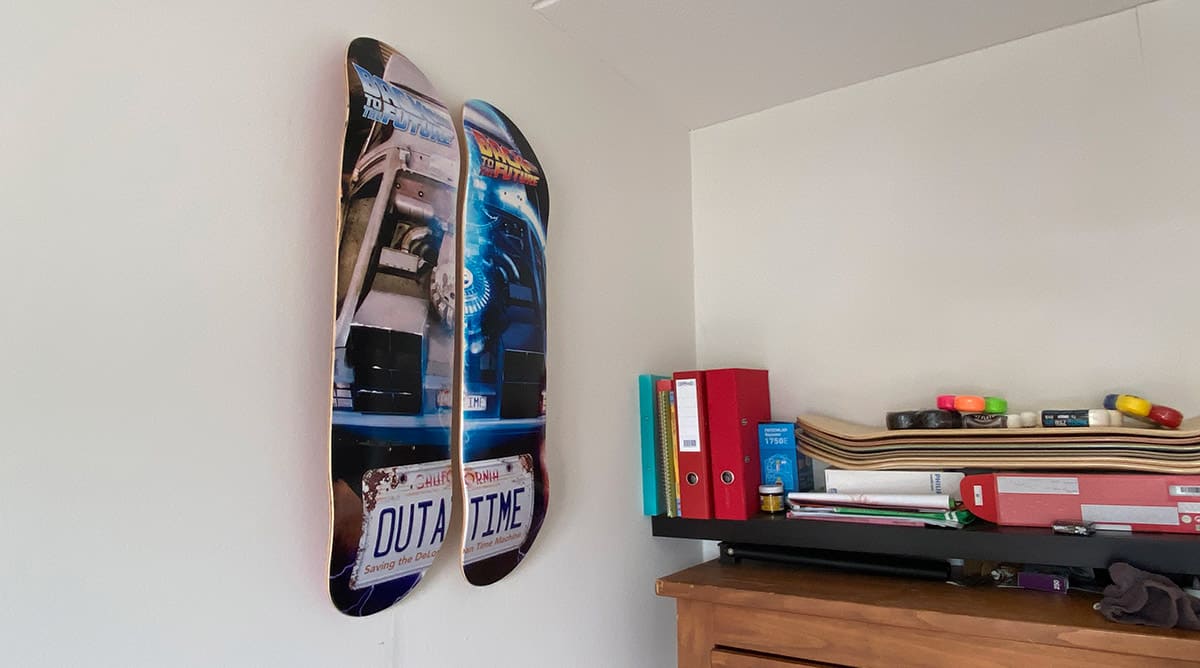

Articles
How To Store A Skateboard
Modified: August 17, 2024
Learn the best techniques and tips for storing your skateboard in this informative article. Keep your skateboard safe and ready for your next ride.
(Many of the links in this article redirect to a specific reviewed product. Your purchase of these products through affiliate links helps to generate commission for Storables.com, at no extra cost. Learn more)
Introduction
Welcome to our comprehensive guide on how to store a skateboard. Whether you’re an avid skateboarder or simply enjoy cruising around the block on your board, proper skateboard storage is crucial to keep your equipment in top-notch condition. Storing your skateboard correctly not only helps prevent damage but also ensures that it’s ready for action whenever you’re ready to hit the streets again.
Skateboards are made up of various components, including the deck, trucks, wheels, bearings, and grip tape. Each component requires proper care and attention to maintain its performance and longevity. Improper storage can lead to issues like warping, wheel deformation, bearing damage, and even grip tape wear and tear.
In this guide, we’ll walk you through the step-by-step process of how to store a skateboard properly. From cleaning the board to choosing the right storage spot and utilizing various storage options, we’ll cover everything you need to know to keep your skateboard in excellent condition.
So, whether you’re temporarily putting your skateboard away for the winter or simply need a secure spot to keep it when it’s not in use, let’s dive in and explore the world of skateboard storage!
Key Takeaways:
- Proper skateboard storage involves thorough cleaning, removing trucks and wheels, wrapping for protection, choosing the right storage spot, and utilizing options like hanging, racks, or bags.
- Avoid common storage mistakes such as exposure to elements, stacking or leaning skateboards, neglecting cleaning and maintenance, using improper storage methods, and forgetting to secure the skateboard.
Read more: How To Store Store-Bought Bread
Step 1: Cleaning the Skateboard
Before storing your skateboard, it’s essential to give it a thorough cleaning to remove any dirt, grime, or debris that may have accumulated during use. Cleaning your skateboard not only keeps it looking good but also helps prevent any damage that could occur from prolonged exposure to dirt and moisture.
Here’s how you can clean your skateboard:
- Gather your supplies: You’ll need a soft cloth or sponge, water, mild soap or skateboard-specific cleaner, and a towel.
- Remove the wheels: Start by loosening the nuts on the trucks and carefully removing the wheels from the axle. This will make it easier to clean the deck without obstructions.
- Clean the deck: Dampen the cloth or sponge with water and add a small amount of mild soap or skateboard cleaner. Gently scrub the deck in circular motions, paying close attention to any areas with stubborn stains or dirt buildup. Avoid using harsh chemicals or abrasive scrub brushes, as these can damage the grip tape or graphics on the deck.
- Rinse and dry: Once you’ve thoroughly cleaned the deck, rinse it with clean water to remove any soap residue. Use a towel to dry it completely, ensuring that no moisture remains.
- Clean the grip tape: If your skateboard has grip tape, you’ll want to clean it separately. Use a damp cloth or sponge to scrub the grip tape gently. Avoid soaking the grip tape, as excessive moisture can cause it to peel or lose its grip. Once you’ve cleaned it, use a towel to blot away any excess moisture.
- Clean the wheels and trucks: Take the opportunity to clean the wheels and trucks as well. Use a damp cloth to wipe them down, removing any dirt or debris that may have accumulated. If necessary, you can also use a mild cleaner specifically designed for skateboard wheels.
- Reassemble the skateboard: Once all the components are clean and dry, reattach the wheels to the axle, making sure they are tightened securely but not too tight.
By following these steps, you’ll have a clean skateboard that’s ready to be stored properly. Cleaning your skateboard regularly not only helps maintain its appearance but also prevents dirt and debris from causing unnecessary wear and tear on the components. With your skateboard cleaned, it’s time to move on to the next step: removing the trucks and wheels.
Step 2: Removing the Trucks and Wheels
Once you’ve cleaned your skateboard, the next step in proper skateboard storage is to remove the trucks and wheels. This step is essential as it helps in preserving the integrity of the trucks and reduces the risk of any damage during the storage period.
Here’s how you can remove the trucks and wheels from your skateboard:
- Gather the necessary tools: You’ll need a skate tool or a wrench to unscrew the nuts on the trucks.
- Flip your skateboard upside down: Place your skateboard on a flat surface with the deck facing downwards. This will make it easier to access the trucks.
- Loosen the nuts on the trucks: Use your skate tool or wrench to loosen the nuts on the trucks, but don’t remove them completely just yet.
- Remove the wheels: Once the nuts are loosened, gently lift the skateboard and slide the wheels off the axle. Be careful not to damage the bearings or any other components in the process.
- Remove the trucks: With the wheels out of the way, you can now fully remove the nuts and trucks from the skateboard. Keep the nuts and trucks in a safe place, such as a small container or a ziplock bag, to avoid misplacing them.
By removing the trucks and wheels, you reduce the risk of them getting damaged or bent during storage. It also allows for better storage options, such as wrapping or using a skateboard rack, which we’ll discuss in the following steps.
Once you’ve removed the trucks and wheels, you can move on to the next step of properly storing your skateboard: wrapping it for protection.
Step 3: Wrapping the Skateboard
After cleaning your skateboard and removing the trucks and wheels, it’s time to protect it by wrapping it securely. Wrapping your skateboard not only shields it from dust and debris but also helps prevent any accidental scratches or dings that may occur during storage.
Here’s how you can wrap your skateboard:
- Choose the right wrapping material: Look for a soft, non-abrasive material to wrap your skateboard. Microfiber towels or bubble wrap are excellent options as they provide cushioning and protection.
- Place the wrapping material on the deck: Lay the microfiber towel or bubble wrap flat on a clean surface, making sure it’s large enough to wrap around the entire skateboard.
- Position the skateboard on the wrapping material: Carefully place your skateboard deck on top of the wrapping material, ensuring that it’s centered and aligned.
- Wrap the skateboard: Start by folding the edges of the wrapping material over the deck, creating a snug and secure covering. Use tape or rubber bands to hold the wrapping material in place.
- Secure the ends: Once the skateboard is wrapped, secure the ends of the wrapping material using tape or rubber bands. Make sure it’s tightly sealed to prevent any dust or debris from entering.
By wrapping your skateboard, you provide an extra layer of protection against potential damage. The wrapping material cushions the skateboard and prevents any unnecessary scratches or marks while it’s in storage.
Now that your skateboard is securely wrapped, it’s time to move on to the next step: choosing the right storage spot.
Step 4: Choosing the Right Storage Spot
When it comes to storing your skateboard, selecting the right storage spot is crucial. You want to find a location that is dry, secure, and away from any potential hazards that may cause damage to your skateboard.
Here are some factors to consider when choosing the right storage spot for your skateboard:
- Avoid moisture: Moisture is one of the biggest enemies of a skateboard. Choose a storage spot that is dry and free from any potential water leaks. Avoid storing your skateboard in a damp basement or garage where moisture can easily seep in.
- Avoid extreme temperatures: Extreme temperatures can also affect the performance and longevity of your skateboard. Avoid storing it in areas that are subject to excessive heat or cold, such as near radiators, heaters, or windows.
- Consider sunlight exposure: Prolonged exposure to direct sunlight can cause the colors on your skateboard deck to fade. Look for a storage spot that is away from direct sunlight, such as inside a closet or under a bed.
- Secure against accidental damage: Choose a spot that is away from heavy foot traffic or any potential hazards that may cause accidental damage to your skateboard. Ensure that it’s not at risk of being knocked over, stepped on, or bumped into.
- Consider storage space: Take into account the size and space availability of the storage spot. Make sure it’s large enough to accommodate your wrapped skateboard without any constraints.
By considering these factors, you can find a suitable storage spot that provides optimal conditions and protection for your skateboard. Once you have chosen the right storage spot, it’s time to move on to the next step: hanging the skateboard.
Read more: How To Store Basil From Grocery Store
Step 5: Hanging the Skateboard
Hanging your skateboard is an excellent storage option that keeps it off the ground and minimizes the risk of accidental damage. By hanging your skateboard, you not only save space but also showcase it as a piece of functional art.
Here’s how you can properly hang your skateboard:
- Choose a suitable wall mount or hooks: Look for a wall mount or hooks specifically designed for skateboards. These are typically made of durable materials and provide a secure grip on the skateboard.
- Decide on the hanging position: Determine how you want to display your skateboard – vertically or horizontally. Both orientations are valid options, so choose the one that suits your preference and available space.
- Measure and mark the desired position: Use a measuring tape to determine the ideal height and spacing for mounting the hooks or wall mount. Mark the positions on the wall using a pencil or masking tape.
- Install the hooks or wall mount: Following the manufacturer’s instructions, fasten the hooks or wall mount onto the marked spots on the wall. Make sure they are installed securely and can support the weight of your skateboard.
- Hang the skateboard: Gently place the skateboard onto the hooks or wall mount, ensuring that it sits securely in place. If hanging it vertically, make sure the grip tape is facing outwards for a visually appealing display.
By hanging your skateboard, you not only keep it safe from potential damage but also create a cool and stylish display. It’s a great way to show off your skateboard collection or keep it easily accessible for quick grabs whenever you’re ready to ride.
If hanging your skateboard is not a viable option, don’t worry. There are other storage solutions available, such as using a skateboard rack or storing it in a bag or case, which we’ll explore in the following steps.
When storing a skateboard, it’s best to keep it in a cool, dry place to prevent warping. You can also hang it on the wall using specialized skateboard racks to save space and keep it safe from damage.
Step 6: Using a Skateboard Rack
If hanging your skateboard on the wall is not an option, using a skateboard rack is another convenient and space-saving storage solution. A skateboard rack allows you to store multiple skateboards in an organized manner, keeping them securely in place.
Here’s how you can use a skateboard rack to store your skateboards:
- Select a suitable skateboard rack: Look for a skateboard rack that can accommodate the number of skateboards you have. There are various types available, including wall-mounted racks, freestanding racks, and portable racks.
- Choose a location for the rack: Find a suitable spot in your room or garage to install or place the skateboard rack. Make sure it is easily accessible and doesn’t obstruct any walkways or doors.
- Assemble the rack: Follow the manufacturer’s instructions to assemble the skateboard rack. Ensure that all parts are securely connected, and the rack is stable and sturdy.
- Position the skateboards: Place the skateboards on the rack one by one, making sure they are evenly spaced and securely held in place. If the rack has individual slots, slide each skateboard into its designated slot. If the rack has hooks, hang the skateboards by the trucks.
- Adjust and secure: Once all the skateboards are positioned, adjust them to ensure they are aligned and stable on the rack. Double-check that they are securely held in place and won’t accidentally fall or get knocked over.
Using a skateboard rack not only keeps your skateboards organized but also protects them from potential damage caused by stacking or leaning them against walls. It’s a great solution for skateboard enthusiasts with multiple boards or for families with multiple skateboarders in the household.
If you prefer a more portable storage option, or if you need to transport your skateboard, consider storing it in a bag or case, which we’ll explore in the next step.
Step 7: Storing the Skateboard in a Bag or Case
If you need to store or transport your skateboard more conveniently, using a bag or case designed specifically for skateboards is a practical solution. A skateboard bag or case provides additional protection from dust, moisture, and accidental damage, making it an excellent choice for both short-term and long-term storage.
Here’s how you can store your skateboard in a bag or case:
- Select a suitable skateboard bag or case: Look for a bag or case that fits the size of your skateboard. There are different types available, including backpack-style bags, shoulder bags, or padded cases with handles or straps.
- Clean and dry your skateboard: Before placing your skateboard in the bag or case, ensure that it is clean and dry, as any dirt or moisture can lead to damage over time.
- Remove the trucks and wheels (optional): If you prefer a more compact storage solution or if you have a larger bag or case that can accommodate disassembled components, you can remove the trucks and wheels for a snug fit. Just remember to store them safely in a separate bag or container.
- Open the bag or case: Unzip the bag or open the case to create a suitable space for your skateboard.
- Place the skateboard inside: Gently slide your skateboard into the bag or case, ensuring that it rests securely and is centered to prevent any unnecessary strain or pressure.
- Close and secure the bag or case: Zip up the bag or securely close the case, making sure it is fully sealed. If the bag or case has straps or buckles, fasten them for extra security.
Storing your skateboard in a bag or case not only provides protection from external elements but also offers a discreet storage option, especially if you need to keep your skateboard out of sight. It’s also convenient for transportation when you’re heading to the skate park or traveling.
If you’d like a more visible and easily accessible storage solution for your skateboard, consider using a skateboard rack or wall mount, which we discussed in previous steps.
Step 8: Storing the Skateboard in a Skateboard Rack
If you prefer a visible and easily accessible storage option for your skateboard, using a skateboard rack is a great choice. A skateboard rack not only keeps your skateboard organized but also adds a stylish touch to your space.
Here’s how you can store your skateboard in a skateboard rack:
- Select a suitable skateboard rack: Look for a skateboard rack that fits your needs and available space. There are various types available, including wall-mounted racks, freestanding racks, and portable racks.
- Choose a location for the rack: Find a suitable spot in your room, garage, or skateboarding area to install or place the skateboard rack. Ensure that it is easily accessible and doesn’t create any obstructive barriers.
- Assemble the rack: Follow the manufacturer’s instructions to assemble the skateboard rack. Make sure all parts are securely connected, and the rack is stable and sturdy.
- Position the skateboards: Place your skateboards on the rack one by one, ensuring they are spaced evenly and securely held in place. If the rack has individual slots, slide each skateboard into its designated slot. If the rack has hooks, hang the skateboards by the trucks.
- Adjust and secure: Once all the skateboards are positioned, adjust them to ensure they are aligned and stable on the rack. Double-check that they are securely held in place and won’t accidentally fall or get knocked over.
Storing your skateboard in a skateboard rack not only keeps it organized and readily available but also prevents any potential damage from stacking or leaning against walls. It’s a functional and visually appealing storage solution for skateboard enthusiasts or anyone looking to showcase their collection.
If a skateboard rack is not an option for you, consider using other storage methods such as hanging the skateboard or storing it in a bag or case, which we discussed in previous steps.
Read more: How To Store Jordans
Step 9: Storing the Skateboard in a Wall Mount
If you’re looking for a space-saving and visually appealing storage option for your skateboard, using a wall mount is an excellent choice. A wall mount allows you to display your skateboard like a piece of art while keeping it secure and easily accessible.
Here’s how you can store your skateboard in a wall mount:
- Choose a suitable wall mount: Look for a wall mount specifically designed for skateboards. There are different types available, including horizontal wall mounts and vertical wall mounts.
- Choose a location for the wall mount: Find a suitable spot on the wall where you want to display your skateboard. Ensure that it is easily visible and doesn’t obstruct any walkways or doors.
- Measure and mark the desired position: Use a measuring tape to determine the ideal height and spacing for mounting the wall mount. Mark the positions on the wall using a pencil or masking tape.
- Install the wall mount: Following the manufacturer’s instructions, attach the wall mount to the marked spots on the wall. Make sure it is securely fastened and can hold the weight of your skateboard.
- Position the skateboard: Gently place your skateboard onto the wall mount, ensuring that it sits securely and is centered. If using a horizontal wall mount, the skateboard should rest with the grip tape facing outwards for an appealing display.
Storing your skateboard in a wall mount not only saves space but also adds a unique aesthetic to your room or skateboarding area. It’s a great way to showcase your skateboard while keeping it safely secured and easily accessible for whenever you’re ready to ride.
If wall mounting is not an option for you, consider using alternative methods such as a skateboard rack or storing it in a bag or case, which we discussed in previous steps.
Step 10: Avoiding Common Storage Mistakes
When it comes to storing your skateboard, it’s important to avoid common mistakes that can lead to damage or deterioration over time. By following a few simple guidelines, you can ensure that your skateboard stays in great condition while it’s in storage.
Here are some common storage mistakes to avoid:
- Leaving it exposed to the elements: Avoid storing your skateboard in areas where it’s exposed to excessive moisture, heat, cold, or direct sunlight. These environmental factors can damage the components of your skateboard.
- Stacking or leaning skateboards: Don’t stack or lean your skateboards against walls or other objects. Stacking can cause pressure or deformations, while leaning makes them susceptible to accidental falls or damage.
- Ignoring cleaning and maintenance: Clean your skateboard regularly and check for any signs of damage or wear. Neglecting cleaning and maintenance can lead to issues down the line, such as rusted bearings or warped decks.
- Using improper storage methods: Avoid using storage methods that can cause unnecessary strain or damage, such as storing your skateboard under heavy objects or in cramped spaces.
- Forgetting to secure your skateboard: Make sure that whichever storage method you choose, your skateboard is securely held in place. This helps prevent accidental falls or damage.
By avoiding these common storage mistakes, you can prolong the lifespan of your skateboard and ensure that it remains in optimal condition. Remember to always prioritize proper cleaning, choose suitable storage options, and check on your skateboard periodically to address any maintenance needs.
With these steps and tips, you’re now equipped with the knowledge to store your skateboard properly. By following these guidelines, you can keep your skateboard in excellent shape and ready for your next skateboarding adventure!
Happy skating and happy storing!
Conclusion
Congratulations! You have reached the end of our comprehensive guide on how to store a skateboard. By following the steps and tips outlined in this article, you now have the knowledge and tools to properly store your skateboard and keep it in excellent condition for years to come.
We started by emphasizing the importance of cleaning your skateboard thoroughly, removing the trucks and wheels, and wrapping it to protect it from dust and debris. We then discussed the significance of choosing the right storage spot, whether it’s hanging your skateboard on the wall, using a skateboard rack, or storing it in a bag or case for added protection.
Throughout the process, we highlighted the need to avoid common storage mistakes, such as exposing your skateboard to extreme temperatures or leaving it in areas prone to moisture. By staying aware of these potential pitfalls, you can prevent any damage or deterioration and ensure the longevity of your skateboard.
Remember, proper skateboard storage is essential to maintain its performance and longevity. By taking care of your skateboard, you can enjoy countless rides and tricks without worrying about unnecessary wear and tear.
So, whether you’re temporarily storing your skateboard during the off-season or finding a secure spot to keep it when it’s not in use, you now have the knowledge to make informed decisions and take the necessary steps to store your skateboard correctly.
Thank you for reading, and we hope this guide has been helpful to you. Happy skateboarding and happy storing!
Frequently Asked Questions about How To Store A Skateboard
Was this page helpful?
At Storables.com, we guarantee accurate and reliable information. Our content, validated by Expert Board Contributors, is crafted following stringent Editorial Policies. We're committed to providing you with well-researched, expert-backed insights for all your informational needs.














0 thoughts on “How To Store A Skateboard”